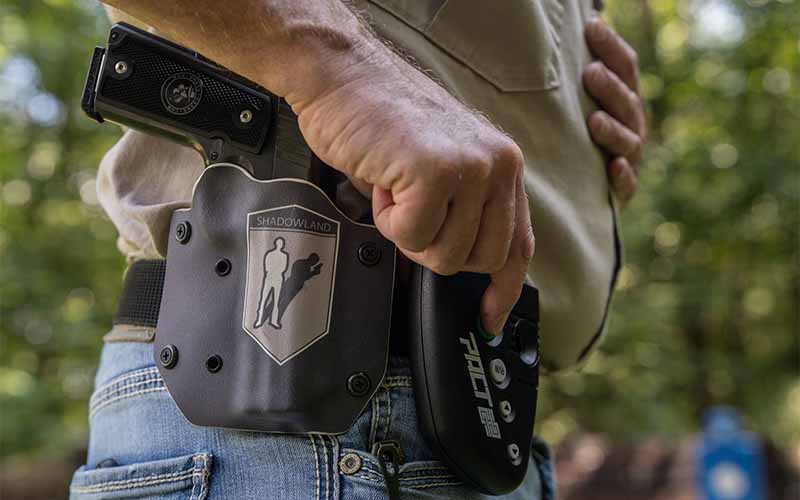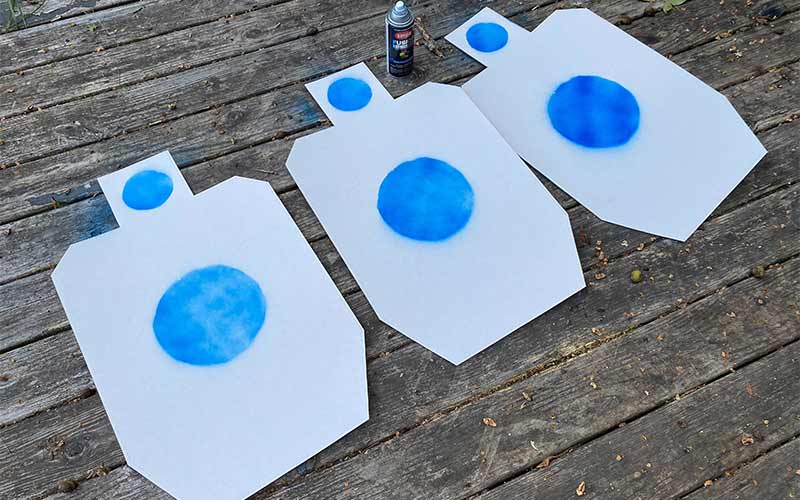
Defensive handgun training doesn’t need to be a slog, so here are a few drills that are both enjoyable and skill-improving.
The variety of defensive handgun drills that can be conducted for training and/or evaluation is endless. When you think you’ve seen them all, just make up another one. Regardless, it’s important you select drills to either help you get better at performing defensive handgun tasks, or drills that can be used to evaluate your ability to perform defensive handgun tasks.
But there’s another thing defensive handgun drills can be used for—and that’s fun. The more fun a defensive handgun drill is to run, the more likely you are to use it.

You’ll see a lot of internet experts criticize defensive handgun drills, because they don’t consider them to be practical. There’s some merit to this analysis, but let’s be realistic: Any drill you conduct that’ll help you become better at using a defensive handgun is a good drill.
If it helps you get better at trigger control, that’s a good thing. If it helps you get better at sight acquisition, that’s a good thing. If it helps you improve transitioning between targets, that’s a good thing.
If we only focused on conducting drills designed to mimic likely, real-world encounters, they would be simple drills where you drew your handgun from concealment and engaged a single target as quickly as possible. Practical doesn’t always precipitate fun.
Attempting to train for a test, when you don’t know exactly what the test will be, requires a more comprehensive approach. Instead of working to only become proficient at what might likely happen, it makes more sense to have a holistic approach to weaponcraft.
Attempt to become at least moderately proficient with a defensive handgun, while using it to do things generally considered integral to its effective application in a situation requiring its use. In other words, learning how to cut down a tree with a chainsaw isn’t enough; you need to know how to trim the limbs and cut up firewood as well.

Enjoying The Process
But let’s get back to the fun part: Learning happens better and is retained easier when it’s paired with fun. The best firearms instructors, teachers and coaches know this. I’ve coached high school soccer for five years, and I can tell you—without exception—that humans absorb lessons best when they’re either painful or enjoyable. You only touch a hot stove one time, and catching a fish is what makes you want to get better at catching fish.
The primary motivation for creating the drill I’m about to detail was fun. The secondary motivation was the need to impart stress into training. And the final reason was to provide a comprehensive means of evaluating the basic application of the defensive handgun.

I call the drill the Shadowland Drill, which is named after the little hacienda we live on in West Virginia. This drill is the amalgamation of five different and very common defensive handgun drills detailed below. All rolled into one, they create a stressful, 14-shot drill, that’ll challenge even very accomplished shooters.
Included Defensive Handgun Drills
1. Single Shot to the Head
This is a common drill requiring speed and accuracy. It’s simple: You draw from concealment and engage a single target with a single head shot. If, at a distance of about 5 yards, you can accomplish this drill in less than 2 seconds, that’s pretty good.
2. Double Tap
There are several names for firing two fast shots into a single target. Most often it’s referred to as a “double tap,” but two quick shots are often described as a “controlled pair” or a “hammer.” We can argue semantics another time. What’s important with this drill is the ability to deliver two kill-zone hits, at about 5 yards, in about 2 seconds.

3. Failure Drill
This is another popular defensive handgun training drill that involves two shots being fired center mass, but it adds an additional and final shot to the head. Generally conducted at about 5 yards, three hits in less than 3 seconds is better than average.
4. Speed Reload
Some consider training for a reload in a defensive situation a waste of time, because most self-defense situations are solved with less than a magazine/cylinder of ammunition. However, you need to be able to reload your handgun swiftly and effectively, and reloading a handgun is a good way to sort out a stoppage. Reloading drills are timed in several ways, but the easiest is to combine a reload with shots before and after. Good reloading times are in the 2-second time frame.

5. Adrenaline Dump/Forty-Five Drill
Being able to put multiple rounds on target in a hurry is a practical skill with a defensive handgun. Often called the “adrenaline dump,” the number of shots could range from three to double that. The key to this drill is good recoil control and a shot cadence that’ll allow you to keep all shots inside a kill zone as quickly as possible.
Shadowland Drill
To start, you’ll need a shot timer and three IPSC/IPDA cardboard targets. Draw or paint an 8-inch circle in the chest area of each target and then paint a 4-inch circle on the head of each target.

Position one target 5 yards to your front—we’ll call this target 3—and then position the other two targets—targets 1 and 2—2.5 yards to your front and 2.5 yards to either side of the first target.
1. At the start signal, draw from concealment and engage target 1 with a single shot to the head.
2. Then, transition to target 2 and conduct a center mass double tap.
3. Next, switch to target 3 and conduct a failure drill.
4. Returning to target 1, you’ll fire another double tap, conduct a speed-load and then engage target 2 with single shot to the head.
5. To finish, engage target 3 with an adrenaline dump, which is often called the Forty-Five Drill, firing five shots center mass.
6. Remember, all five parts of this drill are conducted consecutively under one time; you don’t stop and restart the timer between each part of the drill.

Once complete, you should have one shot in the head zone of each target, two shots center mass in target 1, two shots center mass in target 2 and seven shots center mass in target 3. Par time for this drill is 15 seconds, and your goal should be to complete it within that time limit with no misses. Anything less than 15 seconds is excellent, 15 to 17.5 seconds is very good, and 17.5 to 20 seconds is better than average.
This is a great drill to conduct at the end of a training session, because it’s always fun to end a training session with something enjoyable. It’s also a great drill to use as an informal competition between you and a training partner. Aside from being fun to run, it throws a lot of defensive handgun skills into one box.
You can start the drill from concealment or an open holster; it demands fast sight acquisition, precision shots, varied shot cadence, a speed reload, transitions between targets, recoil control, diverse target responses, weapon manipulation and that you maintain your fighting stance.

Primarily designed for semi-automatic handguns that have a capacity of eight or more, the drill can also be run with pistols of a lesser capacity—or even revolvers. If you’re using a six-shot revolver/pistol, conduct your first reload after you perform the failure drill on target 3. Then, conduct the second reload after the head shot on target 2.
If you’re using a five-shot revolver or pistol, it’s a little more complicated because you’ll have to conduct three reloads. Do the first reload after the first double tap on target 2. Reload again after the failure drill on target 3 and conduct your last reload after the head shot on target 2. You’ll need to adjust the par time; add 2 to 3 seconds for each additional reload.
Is there any chance you’ll have to conduct an engagement like this drill in real life? Well, never say never, but unless you’re auditioning for the next John Wick film, the chances are about the same as President Biden being able to apply basic geometry.
On the other hand, when you consider the possibility of multiple attackers and threat movement, there’s a reasonably—though still small—likelihood you might have to combine two of these shot sequences in a real-world situation.
But, of course, replicating a real-world self-defense engagement isn’t the purpose of the Shadowland Drill. The purpose of the Shadowland Drill is to force you to do a lot of things consecutively, under stress. If you’re competent with a defensive handgun, this drill will prove it. If you need more training and practice, this drill will show that too. But most importantly, the Shadowland Drill is fun!
Editor's Note: This article originally appeared in the EDC 2021 special issue of Gun Digest the Magazine.
More On Defensive Handgun Training:
- 6 Defensive Handgun Drills to Master
- The Shot Timer And Defensive Handgun Training
- Dry Fire Training To Improve Defensive Handgun Skills
- Aiming A Defensive Handgun, Is There One Right Way?
- 7 Steps To Control Fear And Make Sound Decisions Under Stress

Next Step: Get your FREE Printable Target Pack
Enhance your shooting precision with our 62 MOA Targets, perfect for rifles and handguns. Crafted in collaboration with Storm Tactical for accuracy and versatility.
Subscribe to the Gun Digest email newsletter and get your downloadable target pack sent straight to your inbox. Stay updated with the latest firearms info in the industry.

![Best Concealed Carry Guns In 2025 [Field Tested] Wilson Combat EDC X9S 1](https://gundigest.com/wp-content/uploads/Wilson-Combat-EDC-X9S-1-324x160.jpg)


![Best 9mm Carbine: Affordable PCCs [Tested] Ruger Carbine Shooting](https://gundigest.com/wp-content/uploads/Ruger-Carbine-Shooting-100x70.jpg)
![Best AR-15: Top Options Available Today [Field Tested] Harrington and Richardson PSA XM177E2 feature](https://gundigest.com/wp-content/uploads/Harrington-and-Richardson-PSA-XM177E2-feature-100x70.jpg)
